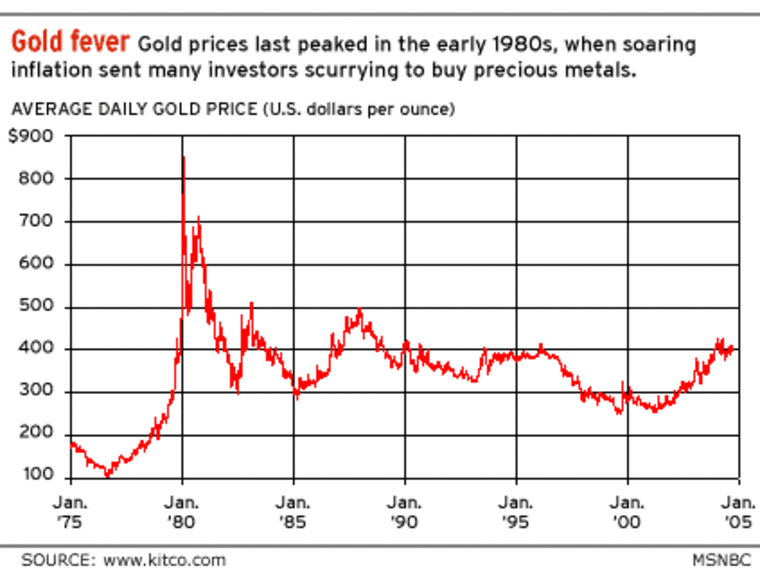Q:I'm thinking about gold investments as a hedge against everything occurring in the world today, i.e., Iraq war, falling dollar, war against terrorists, Iran situation, etc. What is the best way to invest in gold? Several years ago, I heard the best investment method was gold stocks; however, recently I've heard numerous plugs for gold coins. Any recommendations? — Peter R., Glendale, Ariz.
A: It seems like a lot of people – including a number of Answer Desk readers – have been thinking the same thing lately. Gold fever is on the rise again for many of the reasons you’ve cited. Just last month, the New York Mercantile Exchange set a new trading record for gold futures contracts; nearly 1.8 million of them changed hands.
And there have never been more ways to get into the gold game. Historically, the simplest way to add gold to a portfolio has been to buy shares in a company that mines gold or buy into a mutual fund that invests in a bunch of mining stocks. (The main advantage of the mutual fund is that it helps reduce the risk of you picking the one dud in the pack.)
Investors who want to supercharge their gold holdings can buy “managed futures” funds that buy and sell futures contracts. These are just pieces of paper (a contract to buy actual gold) that trade for a fraction of the cost of actually taking delivery on the metal. (Think of gold futures as gold stocks on steroids.) But managed futures funds are usually restricted to high rollers – because you can lose a bundle of money in an instant.
For the rest of us, owning gold got even easier last month with the introduction of a so-called gold ETF, or “exchange traded fund” – complete with its own ticker symbol: GLD. For less than $50, you can buy a share in a trust that holds the gold for you.
But if you’re not in the mood for holding one more piece of paper that represents value –- if you really want to hide some of the shiny stuff under your mattress -– you’ll have to buy either gold coins or gold bullion. That means paying a few bucks to a dealer. And if you buy bullion in any quantity, you’ll have to pay someone to store it -- unless you want to bury it in your back yard.
Alas, despite the rosy predictions of gold dealers and other proponents of holding gold, this metal has had a lousy track record as an investment in the past few decades. True, gold investors had a fabulous run in the late 1970s, when rampant, double-digit inflation sent investors scrambling for cover. By early 1980, the gold soared to $850 an ounce. Then the bubble burst. By June, 1982, an ounce of gold was worth just $300. Since then, the price has bounced around between $250 and $500.

So if you’d bought gold at, say, the $100 trough in 1976 and held it through the bubble to the current price of around $450, you’d be looking at a return of about 350 percent. If you’d invested that same $100 in stocks, you’d be sitting on a return of nearly 1,100 percent – even taking into account the stock market’s 2000-2002 collapse.
In spite of that lousy return, it's not a bad idea to put little bit of your savings in gold to diversify. Why? Modern portfolio theory pays a lot of attention to the “correlation” of various types of investments: large vs. small stocks, international vs. domestic bonds, etc. The idea is that by holding different types of assets that don’t march to the same drummer (those with little “correlation”), you can reduce your risk without sacrificing overall return. When you plow though all of the charts and graphs and decipher the mathematical formulas, it pretty much boils down to the old adage: don’t keep all your eggs in one basket. So gold is just one more way to hedge your bets.
But is gold a "hedge against everything?" Don’t count on it. Just because gold has a storied past –- from Spanish doubloons to the Gold Rush of 1849 -– there’s no assurance that it will remain a reliable shelter of wealth.
Many gold proponents argue that, unlike paper currency, gold retains its value because the supply of gold is “fixed.” While it’s true that, like any mineral, there’s only a certain amount of it on earth, gold production has doubled in the past 25 years, with something north of 80 million ounces added to the market every year. So much for limiting supply. In fact, as gold prices rise, mining companies tend to want to produce more of the metal to take advantage of those high prices. In the past, that's tended to keep a lid on gold prices.
Still, many people bitten by gold fever see the metal as kind of a security blanket against the direst economic circumstances: the complete collapse of the financial markets, global social unrest, a total breakdown of confidence in paper currency, etc. In short, a level of anarchy the world hasn’t seen since, oh, say, the Middle Ages.
The question then becomes: what good would gold be in a world like that? True, we’ve all become conditioned to think of gold as the ultimate currency -– the “gold standard” of wealth. But compared to other precious metals, gold has limited uses besides letting its owner display that wealth. You might as well stash your nest egg in silver or copper. Or crude oil, for that matter.
In the end, any currency is only as good as the willingness of another person to accept it in trade. The question is whether the purchasing power of gold would hold up any better than any other tradable good. Our hunch is you’d probably do just as well with a garage full of big screen TVs.